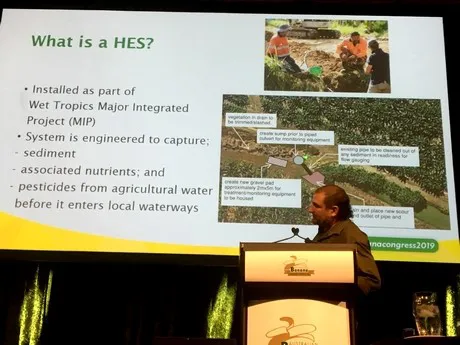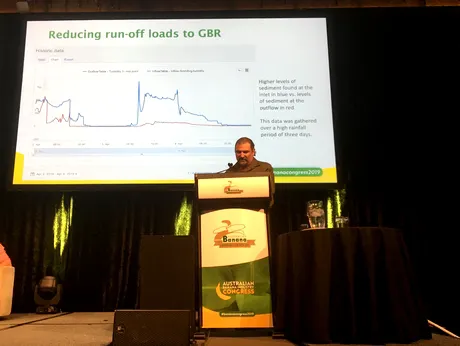A North Queensland banana grower says the introduction of a High Efficiency Sediment (HES) basin on his property has led to a massive reduction of everyday sediment levels.
The system is engineered to capture sediment, and associated nutrients and pesticides from entering the waterways. While the low sediment levels do not factor in high rain events due to the unpredictability of levels and difficulty retaining water for treatment, Innisfail farmer Rob Zahra told fellow growers that it has largely been successful in controlling sediment on his property, since it was introduced in November 2018.
"We have a lot of rainfall up in the north, and my property has some big hills on it, so sediment control for us is a priority," Mr Zahra said. "We need to keep the soil on the paddocks and preventing it from entering our waterways. I am fortunate, due to the geography, design and planning of my property, this treatment system can be effective on my farm. Now that this system has been trialled and proven, I want other growers to think about ways to reduce their impact on the waterways."

The technology used in the system is similar to that used on mining and construction sites, and improves the water quality by using Flocculant Injection System based on rainfall and inflow.
"This is the first instance of the flocculant technology being used in agriculture," Mr Zahra said. "It is used to reduce the amount of heavy and fine sediments, nutrients and pesticides in runoff. Wet tropic farmers are trying to find different systems to reduce impacts on creeks and rivers leading to the Great Barrier Reef, but even growers with the best practices on farm can still experience top soil and fertiliser losses due to the unpredictable nature of the environment. The best we can do beyond that is to look at ways to hold back treatment water before it enters the wider environment."
A month after the HES basin was installed there was a large storm in the region. Mr Zahra says it was a learning curve, and several changes and tweaks were made before the start of the wet season. He added that unlike traditional sediment traps, the High Efficiency Sediment basin, has the improvability to reduce the impacts of runoff through the design.
"I see now with the water quality in the HES basin and with the data supported, the treatment process has been effective during the wet season," he said. "The data shows we are receiving a reduction of 95-100 per cent in sediment, keeping in mind that the extreme rainfall events can vary and make it hard to retain treatment of the water moving through the basin. The flocculant is dosing according to rain and inflow."

Mr Zahra admits that one of the main drivers for looking into this technology on his farm was the environmental benefits.
"We have the power and the responsibility to show the efforts that us farmers go to in managing our land around us," he said. "I am a person who loves my fishing, and the Great Barrier Reef in my eyes is something we need to care of and make some changes on our properties."
